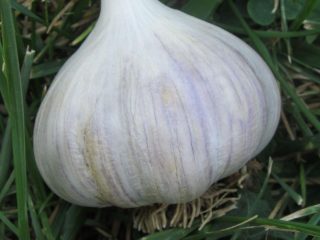Content
Every gardener strives to get the maximum harvest. Winter crops take root best in the Russian climate. They are frost-resistant and have a strong immune system. This group includes Siberian giant garlic. In addition to the listed qualities, it forms large bulbs, which is what made the variety so popular.
Where and how was Siberian giant garlic bred?
The culture was obtained through selection. The name of the originator remains unknown. Siberian giant garlic is sold in most domestic nurseries.
Description of winter garlic Siberian giant
The Siberian giant has a standard color: the outside of the bulb is covered with white husk, with several pink stripes running along the perimeter. The pulp is light yellow. The average weight of garlic is 110 g. One head contains about 7-8 cloves.

When watering Siberian giant garlic, use warm water, the norm is 2 times during the entire growing season.
Taste qualities
The vegetable tastes quite pleasant. Gourmets gave it a rating of 8.0/10.The Siberian giant is used in cooking: for preparing salads, soups, fish and meat, and when preparing food for the winter. The variety has a dense structure, thanks to which it can be stored for a long time.
Ripening and yield
Winter garlic Siberian giant is mid-season. Bulbs ripen within 3-3.5 months after planting. Experts described the variety as high-yielding. This is due to the large diameter of the bulbs.
Disease resistance
During the growing process, one should not exclude the importance of preventive measures. They help prevent the occurrence of diseases and the proliferation of pests. To combat the latter, you can use folk remedies - salt, manganese solution.
To strengthen the immunity of Siberian giant garlic, it is recommended to keep the raw material in a solution of copper sulfate or potassium permanganate. This is done immediately before planting in order to disinfect the raw materials. The soil itself is also sterilized by pouring the solution in the areas of future beds.
The main pest is the nematode worm. It is invisible to the human eye. The parasite overwinters in the soil and moves to plantings in the spring. The worms infect the shoots, causing the leaves to turn yellow and fall off.

It’s not for nothing that the Siberian giant got its name
To combat nematodes, the Siberian giant is treated with a salt solution:
- prepare a 3 liter container;
- fill with water;
- add 1 tablespoon of salt;
- stir.
After this, the pest population should decrease, and all that remains is to “finish off” the worm with repeated treatment.In case of serious damage, the garlic must be dug up and burned, protecting healthy plants.
Siberian giant garlic is rust resistant. During the course of the disease, the following symptoms can be observed:
- drying out of the head;
- the presence of brown formations on the shoots;
- slowdown in development rates.
As a preventive measure, before planting, garlic is heated in the oven (40 degrees) for 9 hours. If the disease has already taken over the crop, spray it with laundry soap or copper sulfate.
Growing regions
The Siberian giant is cultivated in all regions of the Russian Federation. It copes well with temperature changes and quickly adapts to any soil. It is grown in Perm, Surgut, Kirov and other northern cities. Garlic also grows well in warmer climates.
Advantages and disadvantages
Siberian giant garlic is of great value for domestic breeding. It is distinguished by high yield and bulb diameter.

The description of the variety states that Siberian giant garlic (pictured) is resistant to transportation
Pros:
- good disease resistance;
- resistance to frost;
- possibility of growing in different regions;
- average ripening time;
- pleasant taste.
Minuses:
- poor resistance to nematode and rust.
Landing rules
In order for the plant to please with strong bulbs, you need to choose the right place for it. In the garden they are usually planted next to cucumbers, grain crops, and zucchini.

The neighborhood should not be too close so that there is no competition for the possession of nutrients
The soil has been prepared since August. For this:
- regulate the acidity level by adding ash or lime;
- use food additives – mineral complexes;
- disinfect the area with potassium permanganate.
Organic fertilizers cannot be applied - Siberian giant garlic does not tolerate them well. In addition, the risk of pest infestation may increase.
Planting begins in the fall, when the first cold weather sets in (with the exception of prolonged frosts). They rely on the weather forecast and the general climatic factor. The cloves are buried to a depth of 6 cm. An excessively deep hole can have a bad effect on the size of the garlic. On the other hand, if you plant the Siberian giant close to the surface, the shoots will freeze. This is true for the northern regions.
Leave 10 cm of free space between plantings. The holes are separated by the same distance, the rows by 40 cm. Experts recommend sticking to a two-line planting pattern. In this case, the cloves should not be roughly pressed into the ground - this will lead to deformation of the raw material and a waste of time.

The crop is buried in a mixture of compost and soil.
Care instructions
After planting, the garlic is closely monitored. A change in reaction may suggest what the gardener is doing wrong. For example, drying out foliage indicates insufficient watering or infection by a disease or pest. All factors must be excluded.
When the shoots appear, apply the first fertilizer. Botanists advise using a urea solution. Before this, the soil should be thoroughly loosened.The second feeding is carried out in the summer, when the garlic begins to form leaves. During this period, the Siberian giant needs nitrogen-containing mixtures.
Other care activities include daily inspection, aeration, and watering.

Harvesting begins when the arrows begin to burst.
To ensure ripeness, you can dig up the garlic and evaluate the diameter; After this, large-scale cleaning begins.
After a few days, the material will dry out and it can be stored in a heated room. The room is first ventilated and cleared of last year’s residues.
Conclusion
Siberian giant garlic is in demand among gardeners. It is also purchased for commercial purposes. The large heads are weighty and pleasant to the taste. Thanks to its dense structure, garlic is not afraid of transportation and long-term storage, which makes it ideal for cultivation.
Reviews from gardeners about Siberian giant garlic








